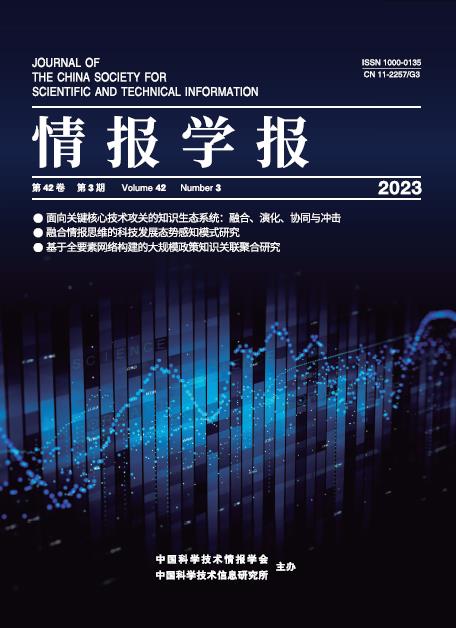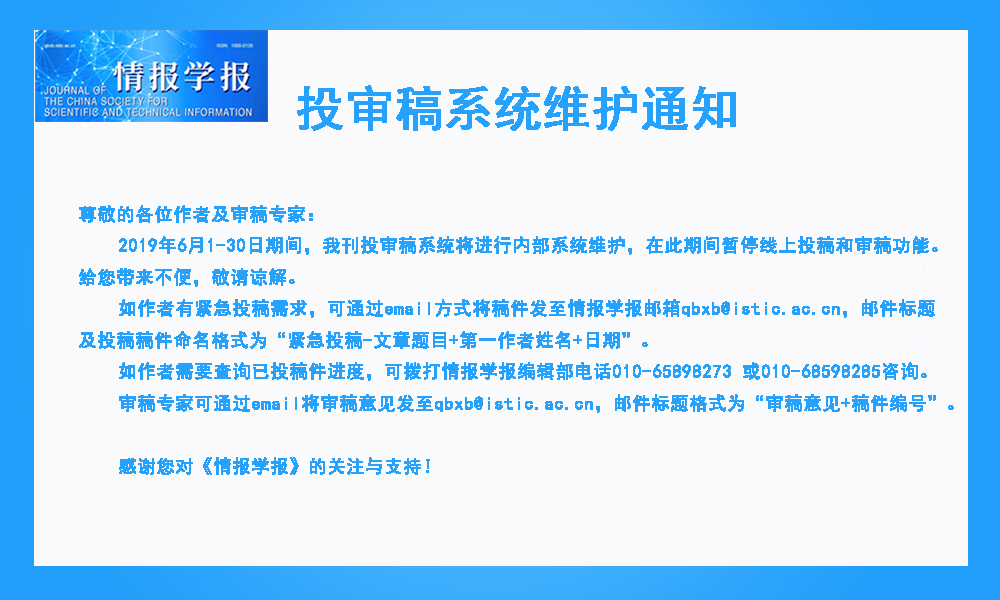 |
|
|
|
|
|
| Intelligence Theories and Methods |
|
|
255 |
The Knowledge Ecosystem for Key Core Technologies: Integration, Evolution, Synergy, and Impact Hot! |
|
 |
Chu Jiewang, An Yiran, Li Jiaxuan |
|
|
DOI: 10.3772/j.issn.1000-0135.2023.03.001 |
|
|
The construction of the knowledge ecosystem is conducive to knowledge sharing, technology sharing, and talent exchange and enhances the capability of the technological innovation system. By exploring the synergy, evolution, integration, and impact of the knowledge ecosystem, the study can resolve the situation in which knowledge subjects are separated from each other and work in isolation, transform the traditional organization and implementation mode of tackling key problems, and collaborate with the key core technology tackling. This study combines the knowledge ecosystem and multiple helix theory, constructs the technology evolution path for key core technologies, the collaboration mode of knowledge subjects, analyzes the environmental impact on knowledge subjects, and finally forms the knowledge ecosystem according to the characteristics of key core technologies and the current situation of tapping. Finally, the study uses the Distribution, Interaction, Competition, and Evolution (DICE) model to explain the operation mechanism of the knowledge ecosystem, takes quantum information technology as an example to study its applicability, and provides a new idea for the construction of a new organizational model for key core technology tackling. |
|
|
2023 Vol. 42 (3): 255-267
[Abstract]
(
236
)
HTML
(181 KB)
PDF
(2642 KB)
(
155
) |
|
|
|
268 |
Examining the Situation Awareness Model for Science and Technology under Intelligence Thinking Hot! |
|
 |
Wang Wei, Yang Jianlin, Liang Jiwen |
|
|
DOI: 10.3772/j.issn.1000-0135.2023.03.002 |
|
|
Global competition in science and technology has increased the demand for effectiveness and currency in intelligence support. Establishing the situation awareness model could be an effective way for intelligence work to provide services for the development and security of science and technology. In this study, we first clarified the interrelationship and applicable scenarios of target-driven, data-driven, and task-driven intelligence. The process of intelligence awareness for science and technology was proposed by integrating the three driving forces. Subsequently, intelligence thinking was introduced for the demand of situation awareness in science and technology. We further clarified the requirement of system thinking, competitive thinking, all-sources thinking, and critical thinking in the intelligence process. Thereafter, the framework of intelligence awareness for science and technology—including the layer of situation awareness, situation understanding, situation prediction, and intelligence delivery—was constructed. The model proposed in this study could guide the realization of intelligence awareness and enhance the ability to support decision-making. |
|
|
2023 Vol. 42 (3): 268-278
[Abstract]
(
229
)
HTML
(97 KB)
PDF
(3400 KB)
(
194
) |
|
|
| Intelligence Technology and Application |
|
|
289 |
Knowledge Association and Aggregation of Large-scale Policy Texts Based on All-factor Network Construction Hot! |
|
 |
Zhang Weichong, Wang Fang, Zhao Hong |
|
|
DOI: 10.3772/j.issn.1000-0135.2023.03.004 |
|
|
The current policy intelligent processing technology lacks deep correlation and effective aggregation of policy text corpus. This technical bottleneck makes it difficult to reuse policy knowledge and convert fragmented texts into systematic knowledge. Guided by theories of policy network, total factor network, and knowledge aggregation, and considering knowledge graph as its technical framework, this study proposes a technical solution for policy text association and aggregation based on total factor network. Using more than 160,000 policies as data samples, we realize the semantic representation and identification of policy texts, knowledge association and aggregation, policy network construction, and policy knowledge aggregation. The high correlation between policies is revealed from multiple dimensions, such as basis and theme. Moreover, large-scale application tests carried out using SARS and COVID-19 cases can provide reference for promoting policy science to effectively solve complex social problems. Finally, a platform prototype for policy intelligent analysis with information integration and network multi-dimensional analysis functions is designed to improve the practical applicability of the technical solution proposed in this study. |
|
|
2023 Vol. 42 (3): 289-303
[Abstract]
(
282
)
HTML
(131 KB)
PDF
(7204 KB)
(
107
) |
|
|
|
304 |
Multi-dimension Public Opinion Mining of Social Media Based on the Hierarchical Viewpoint Tree Hot! |
|
 |
Xi Haixu, Zhang Chengzhi, Zhao Yi, Tian Liang |
|
|
DOI: 10.3772/j.issn.1000-0135.2023.03.005 |
|
|
Mining of public viewpoints on social media can help people quickly and effectively understand them, avoiding subjective and casual comments and spreading wrong information, leading to malignant events. Currently, viewpoint mining on social media mainly analyzes public opinion from a single dimension such as the theme, tendency, or aspect content of viewpoints. It is difficult for people to fully understand public opinion and grasp multi-dimensional information such as the logical relationship between these viewpoints; therefore, the relevant performance of each subtask needs to be improved. To more accurately understand and comprehensively analyze public opinion information of different dimensions and promote people's in-depth understanding of public opinion on social media, this article proposes a construction method of the hierarchical viewpoint tree on social media which reflects the logical relationship between viewpoints in various dimensions, and selects the topic of hydroxychloroquine as the treatment of COVID-19 on Twitter to conduct an empirical study on this topic. The results show that the construction method of the proposed hierarchical viewpoint tree can provide multi-dimensional and understandable viewpoints on social media. |
|
|
2023 Vol. 42 (3): 304-315
[Abstract]
(
235
)
HTML
(140 KB)
PDF
(2465 KB)
(
200
) |
|
|
|
341 |
Analysis of Factors in Citing Scientific Papers in Policies against COVID-19 Pandemic Hot! |
|
 |
Ren Chao, Yang Menghui, Li Kai, Yang Guancan, Lu Xiaobin |
|
|
DOI: 10.3772/j.issn.1000-0135.2023.03.008 |
|
|
In the context of the COVID-19 pandemic, the role of science in supporting policy decision-making has become increasingly important. Scientific papers have gradually become the main reference sources for policy making, and evidence-based decision-making guarantees the scientific development of policies against the COVID-19 pandemic. To explore the factors affecting the citation of scientific papers in policies and evaluate the importance of these factors from the perspective of evidence-based policy making, this study considers scientific papers as research objects and constructs an index system with three levels of influencing factors: primary indices (comprising research evidence factors, internal factors of researchers, and external environmental factors); secondary indices, comprising four important factors in citing scientific papers (namely rationality, originality, and scientific and social values); and 34 characteristics as tertiary indices. By combining five sampling and classification techniques, the accuracy of the influencing factors index system and prediction model reported here was verified. Additionally, the importance of the different factors was explored through feature importance and correlation analyses. The results show that the proposed factors index system, mainly at the three levels of papers, authors, and journals, are important factors affecting the citation of scientific papers in the policies against COVID-19. The results further show that the most important factors affecting the citation of scientific papers in policies are the academic influences of scientific papers and authors and the degree of dissemination of the papers in the news and social media. Concurrently, it was found that the mechanism of citing scientific papers in policy documents is relatively complex, and there is a need for further studies on multiple and complex factors influencing the selection of scientific papers as evidence-based reference sources in policy documents. |
|
|
2023 Vol. 42 (3): 341-353
[Abstract]
(
190
)
HTML
(146 KB)
PDF
(2787 KB)
(
175
) |
|
|
|
354 |
Information Dissemination Model Used in Online Social Networks Based on Hypergraphs Hot! |
|
 |
Shen Wang, Shi Qianru, Wang Junyao, Li He, Liang Shihao |
|
|
DOI: 10.3772/j.issn.1000-0135.2023.03.009 |
|
|
This study describes a network topology with hypergraphs based on pairwise friendship and virtual community friendship in online social networks. To improve the susceptible-infected-removal (SIR) information dissemination model, the individual states are defined after analyzing users’ forwarding and commenting behaviors, and the individual state transition rules are defined based on the social impact theory. The hypergraph network topology and the improved SIR model constitute the proposed network information dissemination model. The NetLogo software is adopted to simulate the proposed model and analyze the influence of the model parameters, such as the community structure. The simulation results show that the network structure based on hypergraphs fits well with the network structure of the virtual community. Moreover, the community structure, social network activeness, and information obsolescence speed have significant effects on the information dissemination process. |
|
|
2023 Vol. 42 (3): 354-364
[Abstract]
(
317
)
HTML
(192 KB)
PDF
(2108 KB)
(
211
) |
|
|
| Intelligence Users and Behavior |
|
|
|
|


